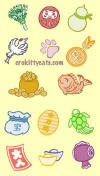On this page you'll find one of the stories of the Maneki Neko as well as an explanation of their symbols and accessories (which decorate the background used on this website). The latter is at the bottom of the page.
Densetsu no Maneki Neko
The Legendary Beckoning Cat
"Nihon wa...Edojidai ni...hijou ni mazushii biku to hijou ni mazushii neko wa hijou ni mazushii jinja ni tsundeita."
In Japan, during the Edo era,
there was a very poor priest and his very poor cat in their very poor
temple. The priest had no money for the upkeep of the temple, nor
did he have any food to fill his belly. Even the mice were
starving and were no meal for his cat Tama-chan. Tama-chan was a
good little cat and felt terrible for the priest's worrying so. As
she pondered what a simple cat like her could do to help, a storm rose
up and showered rain fiercely upon the land.
Naotaka-sama, a very wealthy man, was traveling when the rain ushered
forth. So he hid beneath one of the Sakura trees on the temple
grounds. Tama-chan noticed him resting there, and began calling
out to him. "Nya nya nya!" But Naotaka-sama could not hear
her over the pounding raindrops. Tama-chan felt her hair grow
bristly and knew she had to try harder. She cried again, louder,
and waved her paw to call him over. Her waving paw drew his
attention, and as he joined her on the temple steps, lightning struck
the Sakura tree he'd been standing under. He chose to thank Tama-chan
and the priest by making their poor little temple his family temple.
It was renamed Gotokuji (Gotoku Shrine) in his honour.
This is my favourite of the many Maneki Neko or Beckoning Cat legends. The opening lines in Japanese are from a short one-act table-top puppet play I performed in 2003. Gotokuji does actually exist in the city of Setagaya. You can learn more by visiting the city's English page here.
Depending on colour, design, raised paw, body position, etc, Maneki Neko beckon for all sorts of things. Most commonly you will see them inviting fortune, luck, or customers. They have also managed to become an icon in both Japanese and Chinese culture.
|
This was created solely for the purpose of this
website. The crane, tortoise, money sack, and hammer were based on
the embroidered images on Marl, my dancing matsuri neko. The koban
coin and pot of coins were redrawn from lucky cat stickers I bought.
The rest of the images are original designs by me. All of these
items have been associated with lucky cats. |
|||||||||||||||||||||||||||||
|
|||||||||||||||||||||||||||||
